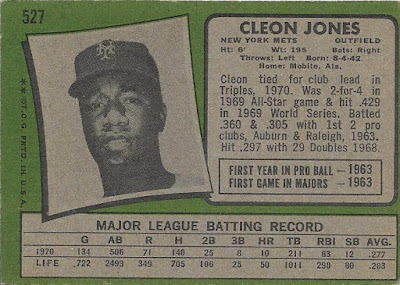Who is the man: Cleon Jones had one heck of a beginning and ending to his 1970 season. He struggled so mightily at the start that he was hitting .167 at the end of May. But he ended the season with a 23-game hitting streak, a record for the Mets at the time.
Can ya dig it: I've said this before, but Jones ages very quickly on his cards. This is the first card in which he appears visibly older than his earlier cards.
Right on: Probably should get a version of this card with a bottom border.
You see that cat Jones is a bad mother: Jones was the Miracle Mets' hitting star, batting a blazing .340 in 1969 and blasting the Braves in the NLCS with a .429 average.
Shut your mouth: Jones' Mets career ended in 1975 after a dugout shouting match with manager Yogi Berra. Jones was unhappy that he was pulled for pinch-hitter Ed Kranepool and refused to go back out on the field, instead storming off to the clubhouse. Berra was so upset over the incident that he told management, it was "him or me." The Mets tried to trade Jones but didn't succeed and he was released. Berra was fired two weeks later.
No one understands him but his woman: Jones was charged earlier in '75 for indecent exposure as police said he was found nude in a vehicle with a 21-year-old woman, who was also charged with indecent exposure and narcotics possession. In an odd press conference after the charges were dropped, Jones appeared at press conference with his wife, Angela, while Mets chairman M. Donald Grant ripped Jones for soiling the Mets' image of "having clean ballplayers." By the way, I'm finding out for the first time that the 21-year-old unemployed waitress was from Johnson City, N.Y., which is the next town over from where I grew up. That was probably big news in the Binghamton Press at the time. I wouldn't know. I was 9 years old.
(A word about the back): The write-up is in error. Jones hit .429 in the 1969 NLCS. He hit .159 in the World Series, but did catch the final out.






















